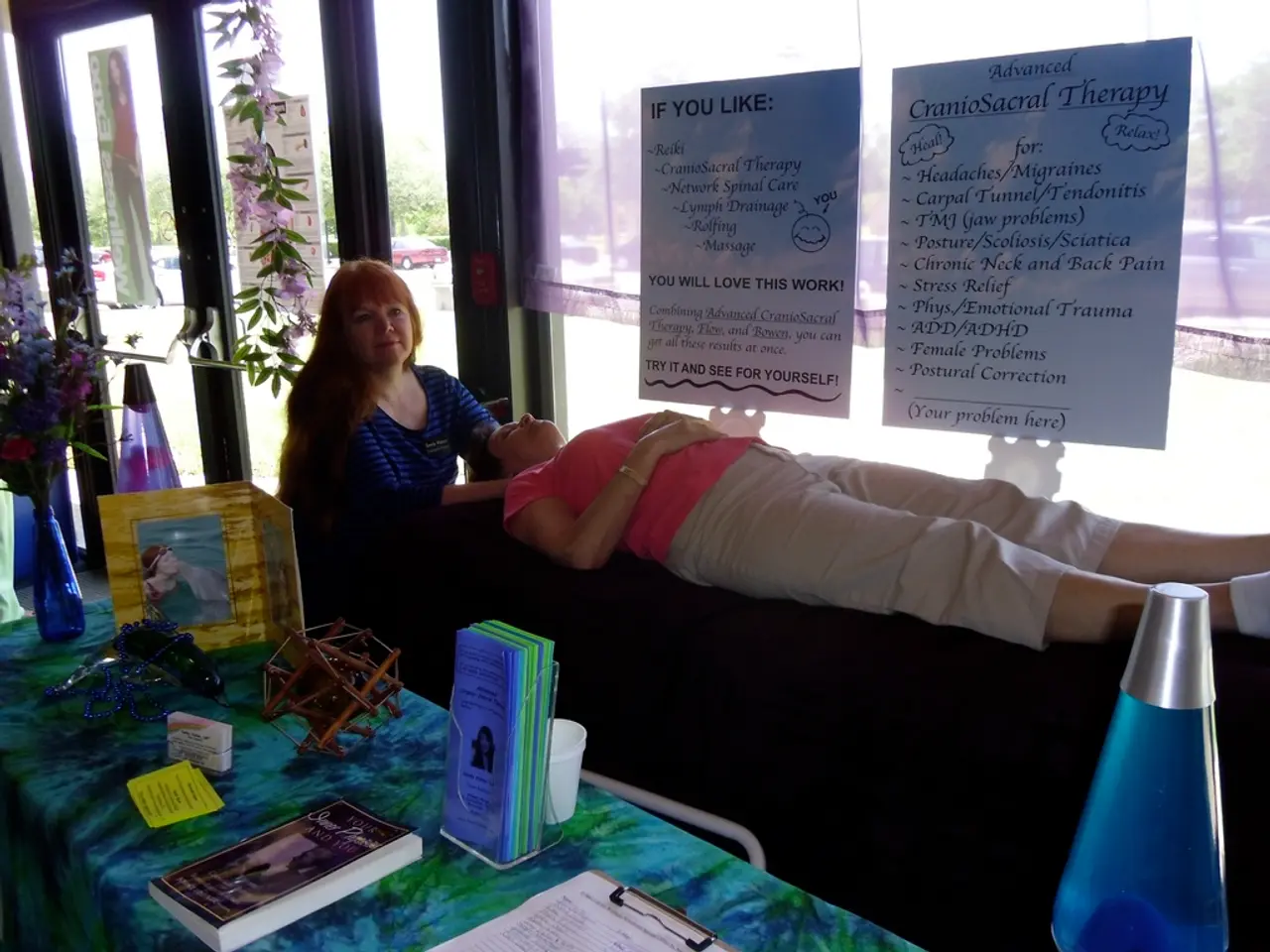Mindfulness's Impact on Alleviating Social Anxiety?
Mindfulness, a practice that involves focusing on the present moment and accepting emotions without judgment, can offer benefits for those struggling with social anxiety disorder (SAD). This approach can be practiced in various ways, from mindful yoga to meditation, and has shown promise in managing symptoms of SAD.
Mindful yoga combines physical postures with breath awareness and meditation, promoting relaxation, body awareness, and present-moment focus. Sitting meditation encourages focusing on breathing, body sensations, feelings, and thoughts to enhance mindfulness. These practices can help reduce rumination, enhance emotional regulation, and lower physiological arousal, potentially aiding those with social anxiety.
Mindfulness-Based Cognitive Therapy (MBCT) is a therapy that combines mindfulness meditation with cognitive behavioral elements. It helps individuals notice and accept negative thoughts without judgment, reducing rumination and emotional reactivity. MBCT has demonstrated effectiveness in reducing anxiety and improving emotional regulation in children and adolescents with anxiety disorders, suggesting benefits in reducing avoidance and enhancing coping skills.
Compared to traditional Cognitive Behavioral Group Therapy (CBGT), MBCT may differ by fostering acceptance of thoughts rather than actively challenging or replacing them, which can be beneficial for some individuals with anxiety. However, direct comparative data between MBCT and CBGT for SAD is sparse. CBGT remains a well-validated approach for SAD, while MBCT may be considered particularly when mindfulness and emotion regulation are therapeutic goals or when patients prefer a mindfulness-oriented approach.
Informal mindfulness practice involves selecting one daily activity to be mindful of each day, such as eating breakfast slowly and savoring it, walking slowly and consciously, and lying down, and just feeling the body before going to bed. Body scans involve systematically focusing attention on different parts of the body, which may help increase bodily awareness, reduce physical tension, and redirect attention away from anxious thoughts. Imagery meditation encourages practicing mindfulness in imagined social situations to become more aware of anxiety triggers and practice responding with more skillful reactions.
However, challenges with meditation practices, especially in the initial stages of learning, have been reported. Mindful walking can help promote present-moment focus and potentially interrupt the cycle of anxious rumination. Cognitive restructuring, a technique that involves learning to identify, challenge, and reframe negative thought patterns that contribute to social anxiety, can complement mindfulness practices. Mindful breathing is a foundational technique that focuses on the breath and serves as an anchor to the present moment.
While mindfulness encourages individuals to confront and explore difficult emotions without avoidance, translating these skills from meditation to real-life, anxiety-provoking social situations can be challenging. Nevertheless, studies have shown that MBCT can alleviate symptoms of SAD, improve quality of life, and increase self-compassion. It offers an alternative for those who don't respond well to CBT, with studies showing significant positive effects on social anxiety symptoms that persist for up to 12 months.
Research on mindfulness for social anxiety has primarily focused on predominantly Caucasian and well-educated populations. Therefore, findings may not generalize to more ethnically and socioeconomically diverse groups. However, several studies suggest that mindfulness-based interventions like Mindfulness-Based Stress Reduction (MBSR) can be beneficial for individuals with SAD.
A study compared the effectiveness of MBSR with CBGT, considered a first-line treatment for SAD. While CBGT demonstrated superiority in reducing social anxiety severity, MBSR compared favorably in improving other aspects of well-being and quality of life. One guided imagery meditation aims to help individuals observe their response in an anxiety-provoking situation and experience the process of waiting for their response to pass.
In conclusion, mindfulness-based therapies offer a promising approach for managing symptoms of SAD. However, more research is needed to clarify the relative effectiveness of MBCT versus CBGT and other traditional therapies in SAD, particularly in diverse populations.
- Mindful yoga, combining physical postures, breath awareness, and meditation, promotes relaxation and body awareness, potentially benefiting those with social anxiety disorder (SAD).
- Sitting meditation encourages focusing on breathing, body sensations, feelings, and thoughts to enhance mindfulness, which can aid in managing symptoms of SAD.
- Mindfulness-Based Cognitive Therapy (MBCT) combines mindfulness meditation and cognitive behavioral elements to help individuals manage negative thoughts and improve emotional regulation in those with anxiety disorders.
- MBCT has demonstrated effectiveness in reducing anxiety and enhancing emotional regulation in children and adolescents with anxiety disorders, suggesting benefits in managing SAD.
- Imagery meditation encourages practicing mindfulness in imagined social situations to become more aware of anxiety triggers and respond with more skillful reactions, potentially aiding those with SAD.
- Mindful breathing serves as an anchor to the present moment, making it a foundational technique for mindfulness practices.
- Translating mindfulness skills from meditation to real-life, anxiety-provoking situations can be challenging for individuals with SAD.
- Studies have shown that MBCT can alleviate symptoms of SAD, improve quality of life, and increase self-compassion.
- Research on mindfulness for SAD primarily focuses on predominantly Caucasian and well-educated populations, and more research is needed to clarify effectiveness in diverse populations.
- Guided imagery meditation aims to help individuals observe their response in an anxiety-provoking situation and experience the process of waiting for their response to pass, potentially benefiting those with SAD.




